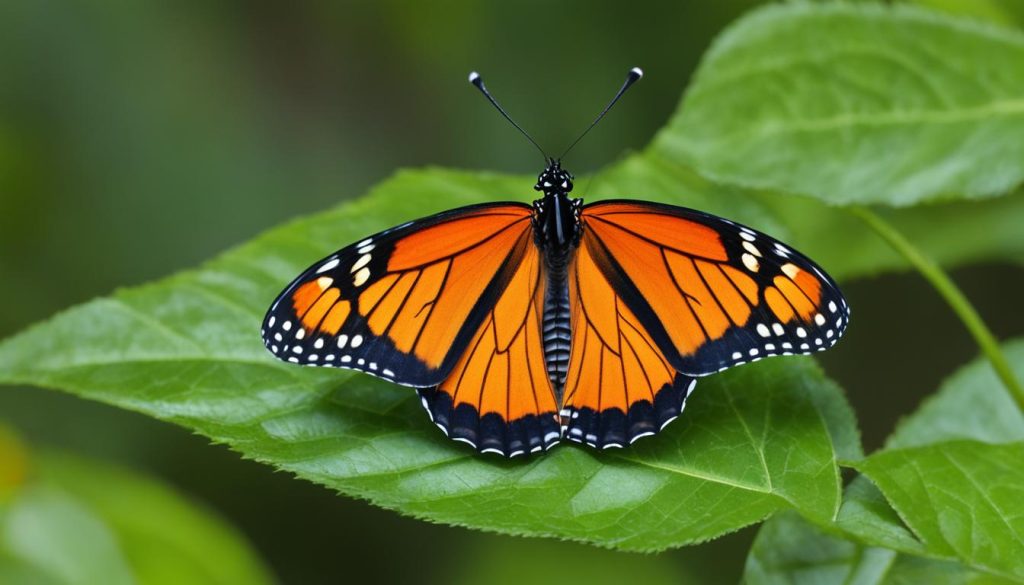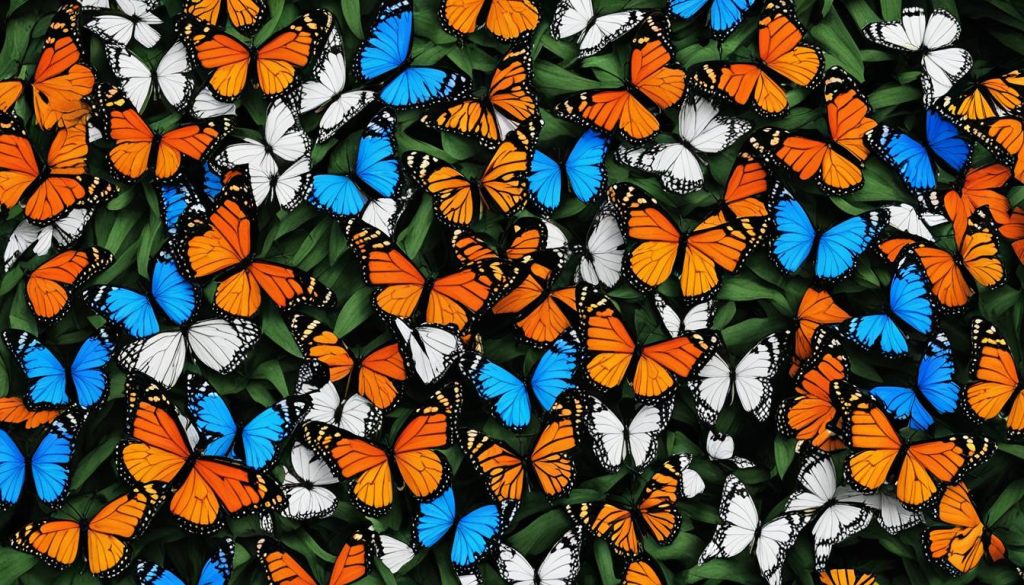Monarch butterflies are known for their vibrant orange color and distinct black markings, making them easily recognizable. However, there are other butterfly species that share similar characteristics, giving them an uncanny resemblance to Monarchs. These Monarch mimics exhibit similar color patterns, wing shapes, and flight behaviors, often confusing observers. Understanding the physical traits and identifying features of these lookalike butterflies can help you distinguish them from genuine Monarchs.
Key Takeaways:
- Monarch butterflies have vibrant orange color and black markings.
- There are several butterfly species that resemble Monarchs.
- Mimicry is a common defense mechanism among butterflies.
- Viceroy butterflies are the most well-known Monarch mimics.
- Other butterflies, such as the Queen, Soldier, and Painted Lady, also resemble Monarchs.
Viceroy Butterfly vs Monarch Butterfly: Spotting the Difference

When it comes to distinguishing between the Viceroy butterfly and the Monarch butterfly, it’s important to look beyond their strikingly similar appearances. While both species share vibrant orange colors and black markings, there are key differences that can help you identify each butterfly accurately.
The Viceroy butterfly, known for being one of the most common Monarch mimics, has a few distinct features that set it apart. Firstly, Viceroy butterflies are slightly smaller than Monarchs. Additionally, they possess an extra black line that runs horizontally across their hindwings, which is absent in Monarchs. This unique marking can be a clear identifying factor when distinguishing between the two species.
Another notable difference between Viceroy and Monarch butterflies lies in their flight patterns. While Monarchs glide gracefully through the air, Viceroy butterflies have a faster and more fluttery flight. This behavior can be observed when closely observing their movements in their natural habitats.
Understanding these distinguishing characteristics is essential in accurately identifying Viceroy butterflies and differentiating them from genuine Monarchs. This knowledge allows you to appreciate the subtle variations in their appearances and gain a deeper understanding of the fascinating world of butterfly mimicry.
By visually comparing the distinguishing features of the Viceroy and Monarch butterflies, you can easily spot the differences between these two species:
| Viceroy Butterfly | Monarch Butterfly |
|---|---|
| Smaller size | Larger size |
| Additional horizontal black line on hindwings | Absence of black line on hindwings |
| Faster and fluttery flight pattern | Graceful gliding flight pattern |
Comparing the physical characteristics and flight behaviors of these butterflies enables enthusiasts like you to confidently identify Viceroy butterflies when encountered in the wild. It’s fascinating to witness nature’s mimicry at play and appreciate the adaptations that make each species unique.
Other Butterflies That Resemble Monarchs

In addition to the Viceroy, there are several other butterflies that bear a strong resemblance to Monarchs. The Queen butterfly shares a similar orange-brown color palette with white spots on its wings, although it lacks the black veins found in Monarchs. Similarly, the Soldier butterfly exhibits an orange and black color scheme, but with a more rounded wing shape and fewer white spots. The Painted Lady butterfly, with its mosaic-like pattern of orange, black, and white, can also be mistaken for a Monarch at times. The Red Admiral butterfly showcases dark wings with red bands and white spots, resembling the orange hue of Monarchs. The Scarlet Mormon butterfly flaunts vibrant red and black colors, mimicking the fiery appearance of Monarchs. Other butterflies, such as the Two-tailed Swallowtail, Danaid Eggfly, Gulf Fritillary, and American Lady, possess some similarities to Monarchs in terms of color and patterns. By familiarizing yourself with these butterflies and their distinguishing characteristics, you can appreciate their unique beauty while still recognizing them as distinct species.
| Butterfly | Features |
|---|---|
| Queen Butterfly | Orange-brown color with white spots; lacks black veins |
| Soldier Butterfly | Orange and black color scheme; rounded wing shape with fewer white spots |
| Painted Lady Butterfly | Mosaic-like pattern of orange, black, and white |
| Red Admiral Butterfly | Dark wings with red bands and white spots |
| Scarlet Mormon Butterfly | Vibrant red and black colors |
| Two-tailed Swallowtail | Similar color and patterns to Monarchs |
| Danaid Eggfly | Similar color and patterns to Monarchs |
| Gulf Fritillary | Similar color and patterns to Monarchs |
| American Lady Butterfly | Similar color and patterns to Monarchs |
Conclusion
Butterflies that resemble Monarchs, commonly known as Monarch mimics, showcase the incredible diversity and adaptability of the butterfly world. Viceroy butterflies, with their additional black line and fluttery flight, are the most well-known Monarch mimics. However, there are other species, including the Queen, Soldier, Painted Lady, Red Admiral, Scarlet Mormon, Two-tailed Swallowtail, Danaid Eggfly, Gulf Fritillary, and American Lady butterflies, that share similar characteristics and color patterns with Monarchs.
Identifying these lookalikes can be a fun and educational experience, allowing you to deepen your understanding of butterfly diversity. By knowing the distinguishing features of these butterflies, you can avoid mistaking them for genuine Monarchs and appreciate their individual beauty. As you embark on your butterfly-watching adventures, keep an eye out for these Monarch mimics and marvel at the wonders of nature’s mimicry.
FAQ
What are some characteristics of Monarch butterflies?
Monarch butterflies are easily recognized by their vibrant orange color and black markings on their wings. They also have a wingspan of about 3.5 to 4 inches.
How can I distinguish Monarch butterflies from other species that look similar?
One way to distinguish Monarch butterflies from similar species is by looking at their flight pattern. Monarchs have a graceful gliding flight, while some lookalikes, such as the Viceroy butterfly, have a faster and more fluttery flight. Additionally, examining the wing patterns and markings can also help differentiate them.
Are there any butterflies that mimic Monarchs?
Yes, there are several butterfly species that mimic Monarchs, including the Viceroy, Queen, Soldier, Painted Lady, Red Admiral, Scarlet Mormon, Two-tailed Swallowtail, Danaid Eggfly, Gulf Fritillary, and American Lady butterflies.
What are the distinguishing features of Viceroy butterflies compared to Monarchs?
Viceroy butterflies are slightly smaller than Monarchs and have an additional black line that runs horizontally across their hindwings. Monarchs do not have this black line.
How can I identify Queen butterflies that resemble Monarchs?
Queen butterflies share a similar orange-brown color palette with white spots on their wings, although they do not have the black veins found in Monarchs.
What are the characteristics of the Soldier butterfly that make it resemble Monarchs?
Soldier butterflies exhibit an orange and black color scheme, but with a more rounded wing shape and fewer white spots compared to Monarchs.
Are there any other butterflies that have similar features to Monarchs?
Yes, the Painted Lady butterfly, Red Admiral butterfly, Scarlet Mormon butterfly, Two-tailed Swallowtail, Danaid Eggfly, Gulf Fritillary, and American Lady butterfly also possess some similarities to Monarchs in terms of color and patterns.
Why do butterflies mimic each other?
Mimicry is a common defense mechanism among butterflies. Species evolve to resemble each other to ward off predators. This phenomenon, known as Müllerian mimicry, is seen in various butterflies, including Monarch mimics.








